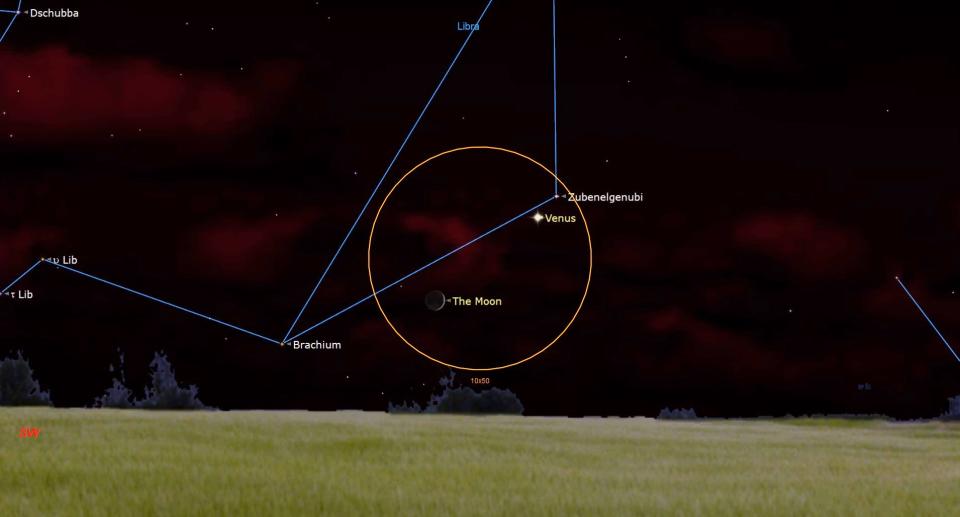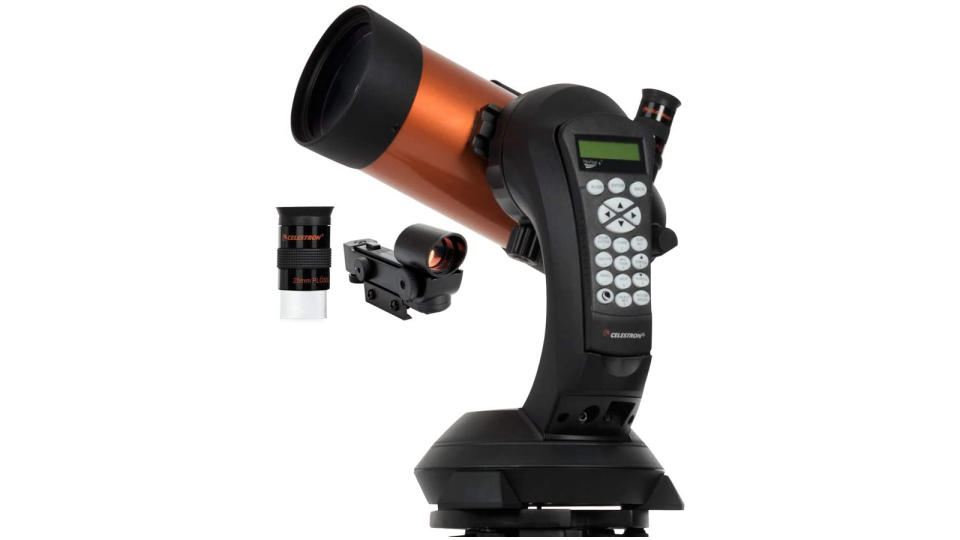When you buy through links on our articles, Future and its syndication partners may earn a commission.


On Saturday evening (Oct. 5) as darkness is falling, be sure to take a look low toward the west-southwest part of the sky for a beautiful celestial tableau formed by a lovely crescent moon and the brilliant planet Venus.
The moon will appear to hover about 4-degrees below and to the left of Venus. Your clenched fist held at arm’s length measures roughly 10-degrees. So, the moon and Venus will appear to be less than a “half a fist” apart. These Venus-moon rendezvous occur on roughly a monthly schedule. Indeed, if Venus were stationary and did not appear to move against the star background, then a Venus-moon encounter would occur every 27 days, 7 hours and 43 minutes.
This is called a “sidereal month” which is the length of time it takes the moon to circle the Earth once, using the background stars as a reference point. So, we try to apply the “sidereal month rule” to this schedule, then the next time Venus and the moon should appear to pair-off would be on Nov. 1.
But if you go out and face west-southwest soon after sundown, you’ll see Venus, but the moon will be nowhere to be found. What happened?
Venus on the move
Celestron NexStar 4SE


The Celestron NexStar 4SE is ideal for beginners wanting quality, reliable and quick views of the night sky. It’s sturdily built, quick to set up and automatically locates night sky targets and provides crisp, clear views of them. For a more in-depth look at our Celestron NexStar 4SE review
Of course, that rule won’t work because Venus is not stationary, but is moving in its own orbit around the sun. In fact, the next time that the moon will pass Venus will come on the evening of Nov. 4. From our earthly viewpoint, Venus will appear to move considerably to the east against the star background.
On Monday night (Oct. 7), Venus will be in the constellation Libra, the Scales. But by next month – on Nov. 4 – it will have appeared to have moved about 38-degrees to the east where it will then reside in the non-zodiacal constellation Ophiuchus, the Serpent Holder.
Related: The next solar eclipse will be a partial eclipse in March 2025
So, the moon had to travel that much more across the sky to catch up to Venus. Since the Moon appears to move across the sky at roughly 13-degrees per day, it needs three more days (13 x 3 = 39) to catch up to Venus.
Indeed, on Nov. 4, we will once again we will be treated to an eye-catching sight in our western twilight between the two brightest objects in the night sky.
And we’re moving too!
Incidentally, another factor that must also be considered is our own Earth’s movement around the sun. If, in fact, you do look for the crescent moon on Oct. 30 you won’t see it because it will be at new phase and hence too near to the sun to be seen. That’s because during the 27 days following Monday night’s Venus-moon pairing, the Earth’s movement around the sun will cause the sun’s position in the sky to shift to the east as well.
And so, in this particular case, come Nov. 4, the sun will appear to have shifted right into the very same region that Venus and the moon occupied on Oct. 3. Of course, by Nov. 4, the moon will have moved well clear of the sun and once again will be readily visible in the west-southwest along with Venus.
Lustrous evening star
Now gleaming at magnitude minus 4.0, Venus in the coming weeks and months will ascend dramatically higher in the western sky and by New Year’s Day it will be setting more nearly 4 hours after the sun. And by February it incredibly will gleam twice as bright as it shines now.
No other star or planet can come close to matching Venus in brilliance, not even brilliant Jupiter which currently is hidden in the glare of the sun. During World War II, aircraft spotters sometimes mistook Venus for an enemy airplane. There were even cases where Venus drew antiaircraft fire.
And from Thanksgiving through Presidents’ Day, it will dominate our evening sky.
Also look for the southern claw
Related Stories:
— Night sky for tonight: Visible planets, stars and more in this evening’s sky
— The brightest planets in September’s night sky: How to see them (and when)
— All solar eclipses will be ‘rings of fire’ in the distant future. Here’s why
Lastly, in addition to Venus teaming up with the moon, it will also be passing rather close to a most notable double star. A low-power scope can also reveal the wide double star Alpha (α) Librae (Zubenelgenubi). This star’s tongue-twisting name is derived from the Arabic al-zubānā al-janūbiyy which means “the southern claw.” While this star now belongs to the zodiacal constellation of Libra the Scales, at one time in the distant past, it marked the tip of the southern claw of Scorpius the Scorpion.
On Saturday evening, Venus and this star will be less than 1-degree apart. Binoculars will be beneficial in seeing all three: moon, Venus and star against the bright twilight sky.
If you’re looking to get a closer view of Venus, the moon and other night sky objects, our best telescopes for beginners guide can help you find what you need. And if something more handheld is your preference, check our our best binoculars guide.
Editor’s note: If you take a stunning photo of Venus and the moon and want to share it with Space.com, send images and comments to our skywatching inbox at spacephotos@space.com.
